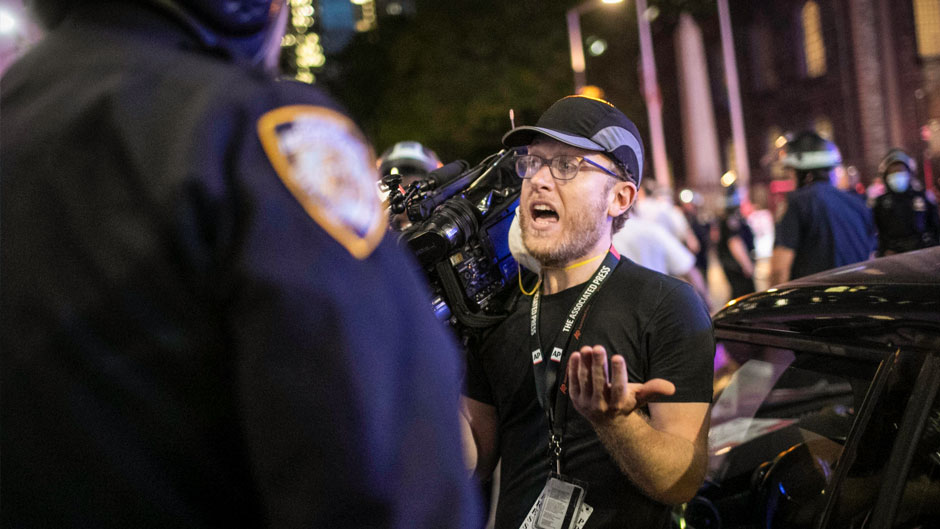Television reporter Kaitlin Rust in Kentucky kept shouting repeatedly, “I’ve been shot, I’ve been shot.”
Freelance photographer Linda Tirado was permanently blinded in one eye because of a rubber bullet fired by police in Minneapolis.
CNN reporter Omar Jimenez was arrested on live television because he allegedly refused to move.
These journalists were suffering attacks as they were doing their job of covering the protests in the aftermath of the death of George Floyd. Some were caught in the mayhem between demonstrators and police. Others were assaulted or detained—even after they identified themselves as members of the news media.
Cars belonging to members of the press have been vandalized. The CNN Headquarters in Atlanta was defaced, and its windows were broken.
Most journalists accept the fact that their job—to gather the news wherever it may be—is fraught with danger. But increasingly in these past few weeks of covering the civil unrest that has rattled the country, members of the media have been assaulted either by the police or demonstrators.
“Politicians and police subjecting journalists to harassment is deeply troubling to civic engagement,” said Karin Wilkins, dean of the University of Miami School of Communication. “Journalists have a critical professional role to play in the witnessing of social activism and injustice.”
The journalist’s role is protected by the First Amendment. But trust in the media has been eroding for decades. A Gallup poll from last September showed that only 41 percent of citizens trusted mass media. Of those, 69 percent were Democrats and 15 percent were Republicans.
Since May 29, at least 125 press freedom violations have been reported nationwide by journalists covering the demonstrations against the death of Floyd. The U.S. Press Freedom Tracker, a nonpartisan website of which the Committee to Protect Journalists is a founding partner, is investigating each report and will publish confirmed incidents to its database.
The tension between the media and the public has been galvanized, observers point out, by President Donald Trump calling the press “the enemy of the people” and putting down the liberal media as creators of “fake news.”
“Politicians have used journalists and the news media as a target for many years,” said Sam Terilli, associate professor of the School of Communication and former general counsel of the Miami Herald Publishing Company.
“I can cite plenty of examples of violence and improper arrests of reporters and photographers by police going back decades,” he added.
But one of the factors aggravating the climate against journalists is the fragmentation of the media landscape, he noted.
“With the rise of the web and social media platforms, the audience is increasingly fragmented and sheltered,” Terilli said. “Many people can—and do—watch, read, and listen to only those outlets with which they already agree, and which also promote divisiveness.”
The partisan coverage of many media organizations who use “political conflict as their brand and as a profitable business strategy” also adds tension to the media landscape, explained Terilli. “Unfortunately, what is good for their businesses is bad for our democracy.”
Tsitsi Wakhisi, associate professor of professional practice at the School of Communication, believes that “targeting journalists is not a new phenomenon.”
“Over time, public figures who seek to thrive or simply survive in the limelight develop media lists of journalists they want to court, journalists they want to shun, and journalists they want to burn,” she said.
As an example, Wakhisi cited a recent incident when Republican Florida Governor Ron DeSantis denied access to Mary Ellen Klas, a Miami Herald/Tampa Bay Times reporter, for complaining that there was no social distancing during the press briefings.
A Herald editorial published after the incident said: “It was vindictive, petty—and illegal. He should be ashamed—not because he thinks he put one over on a reporter, the Times or the Herald. No, to them it’s not personal. Rather, he should be ashamed because, in not allowing Klas to do her job and ask the serious questions that deserve his serious answers, he is really denying access to the Floridians who look to these media outlets for vital information.”
Ultimately, many members of the media say, their role is one of public service and their work is crucial in a democracy.
Wakhisi remembers fondly the many stories during the 60s and 70s that helped shape the future of this country.
“The press helped change America with its prominent coverage of civil, political, and social unrest during the challenges of the civil rights movement, the Vietnam War, and Watergate,” she said.

